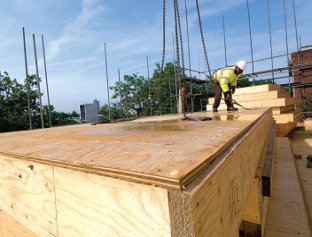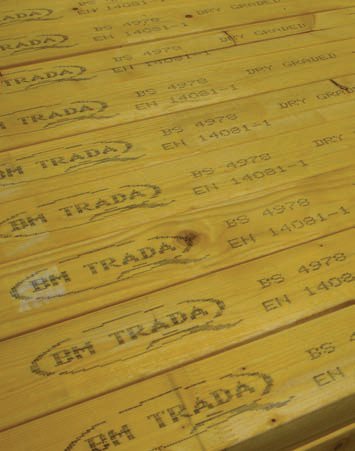Great expectations
5 October 2013Improved construction activity has helped boost the health of the UK timber frame sector. Stephen Powney reports
If you heard a recent BBC Radio 4 feature on timber frame construction, you'd be left with the firm impression that timber frame was the build method of the future.
The BBC correspondent's visit to Persimmon's Space4 factory at Castle Bromwich came at a time of improving prospects for the timber frame sector.
Better housing demand has led to increasing output at volume timber frame manufacturers such as Stewart Milne and Prestoplan, which in turn means more timber and OSB consumption.
Tangible signs of investment are also increasing, including affordable housing developer Green Hill investing £1m in an automated timber frame factory earlier this year, while Mactaggart & Mickel Timber Systems also moved to a new factory with three times the capacity of its old site.
The emphasis in the updated Building Regulations Part L next year will be on the building fabric of homes - tying in nicely with the timber frame industry's Fabric First campaign.
And the relaunch of the UK Timber Frame Association as the Structural Timber Association (STA) to give increased focus and clout for the industry can only be a good thing.
Stories of clay brick and concrete block shortages have also abounded this summer. With quoted lead times on concrete blocks sometimes stretching to three months and bricklayers' rates rising, timber frame is getting an increased look-in from contractors anxious to meet project timetables.
A recent statement by the Brick Development Council acknowledged that increased demand, particularly from the government's Help to Buy scheme, had caused pressures for manufacturers.
In addition, builders merchants have sought to increase brick stocks to more normal levels. "Furthermore, brick customers may have become accustomed to large stocks and therefore immediate availability since 2008. They now need to return to planning their deliveries and placing orders in advance as was standard practice prior to 2008 and the credit crisis," said the council.
"These circumstances have all combined to create a period of very strong demand that the industry is responding to, but it will require some time to adjust."
It said brick manufacturers would bring back mothballed capacity and invest in new plants if demand continued to grow, but warned that brick selling prices had to be sufficient to justify such investment. Stewart Milne Timber Systems said these shortages were likely to change build method dynamics.
The company's group managing director Alex Goodfellow said its major housebuilder customers in southern England were concerned block shortages could last six to nine months.
"We see the shortages as an opportunity because a lot of the private housebuilders are saying they were going to change to timber frame anyway because of the regulations requiring more thermally-efficient houses."
"We have been told by some of the major housebuilding groups that they are instructing their divisions to start considering timber frame for part of their business," he said. "When the block shortage blows over I think they will have a mindset that they have enjoyed a good service and retain a percentage of timber frame business. Our market share will have grown as a result of this."
He said the use of bricks for timber frame external skins had not been greatly affected because this part of the build was not so time critical as the main structure.
Increase in timber frame specification
Preston-based timber frame manufacturer Prestoplan said the shortage of concrete blocks had created a small increase in timber frame specification, mainly from the contractor end of the market.
Managing director Ian Loughnane said masonry material price increases and a shortage of bricklayers were also pushing up costs for builders and contractors, while memories of the problems created for masonry construction by the last harsh winter were also starting to surface in contractors' minds.
"We are seeing an increase in the volume and quantity of enquiries," said Mr Loughnane. "There is still an issue in terms of project pricing as contractors are still tending to price work on tenders with tight margins. But I expect to see a move in the next 12 months."
Mr Loughnane estimated Prestoplan's turnover to be up 30% in 2013 to about £20m, while a reorganisation of factory operations this year (including the disposal of the Quedgeley site) has led to a 15-20% increase in capacity at Preston.
"We are quite optimistic for the next 12 months and looking forward to reversing the negative trend of the past 4-5 years. "The shortage of housing is going to get to chronic levels," he added. "We hope someone wakes up and realises that our industry is ready to meet the challenges. But to do this we need the right commercial and economic conditions to invest in growing the capacity."
The company is expecting to submit its Urban Advantage panel system, which incorporates fire-resistant calcium silicate exterior sheathing boards, to the Structural Timber Association's product approval board. The system is being used in two large student accommodation developments currently on site - at King's College London and Manchester Metropolitan University (combined 1,600 units).
Apartment construction
Meanwhile, Stewart Milne Timber Systems welcomed the return of the apartment construction business with the improved availability of mortgages. This sector - important for timber frame - had slowed during the past five years as builders refocused on standard low-rise housing, predominantly in brick and block.
Stewart Milne Timber Systems' enquiry levels in August (£18m) were at the biggest monthly level for five years, with an increase of 40% on the average enquiry levels (£10m).
Recent landmarks for Milne include 200 houses for the Glasgow Commonwealth Games village and landing its largest single site project - a 2,600-bed student accommodation build for the University of Hertfordshire. It will also feature a six-storey Sigma closed panel structure, following the recent BBA approval of the Sigma system to be used up to six levels.
Stewart Milne claims Sigma is currently the only closed panel timber frame system to be approved for use up to six storeys.
Also of interest is the fact that about 60% of Milne's wall production is now C-Stud panels (two 63x38mm softwood studs linked by a 9mm OSB web) rather than solid wood CLS. Closed panel construction could take more of the construction market in the future.
David Craddock, of EBS elk Ltd, reported high demand for the company's Austrian-made off-site manufactured buildings.
"There is an upturn in the market," he said. "We are seeing an awful lot more enquiries and the conversion rate has gone up. We are looking at a number of school projects with local authorities who have a real demand and are unable to meet that demand with traditional building systems."
EBS elk has won a series of student accommodation contracts at Oxford University colleges. Its recently completed the 200-bed Chapel Street project in the heart of the city will be followed by a further two projects. The company also has plans to invest in a UK production plant, with an interim operation hoped to be up and running in the next couple of years.
Engineered timber
Meanwhile, on the materials front, fingerjointed structural timber is being tipped for increasing use, according to south-east England-based Beaumont Forest Products. Beaumont has been successfully using a Latvian-made finger-jointed stud product it has branded Tru-Stud. It has helped reduce call-back problems associated with regular carcassing.
Beaumont's Andy Ferguson sees a bright future for the product because of its straightness and quality, with a low average moisture content of 12-14% and the ability to supply exact thicknesses and lengths to order.
He said it had saved contractor customers money because of reduced waste.
"There is an increased acceptance of modified and engineered wood products," said Mr Ferguson. "We believe this is the way wood will be sold in the future."


